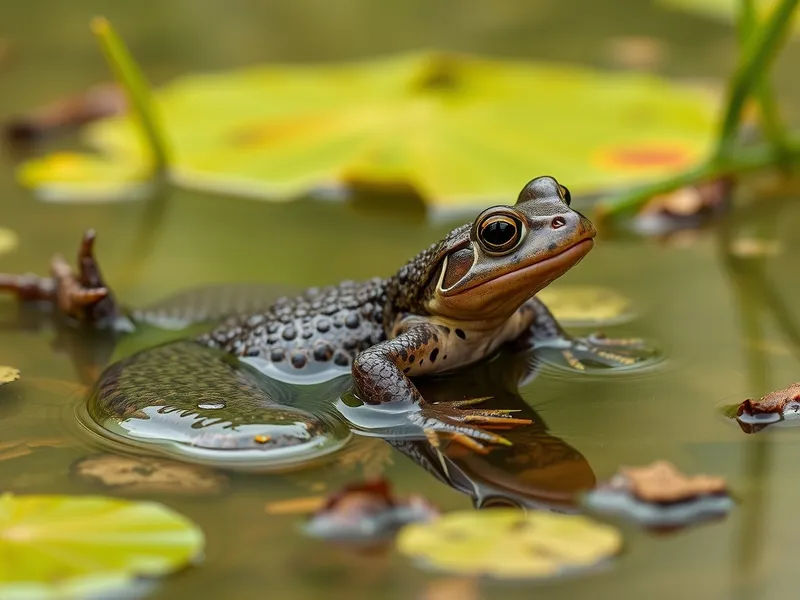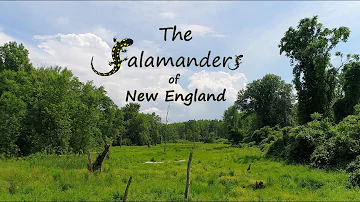
Eastern Newt
Notophthalmus viridescens

Meet the Eastern Newt
The Eastern Newt is a small, semi-aquatic amphibian native to eastern North America. It is well known for its complex life cycle, which includes a bright orange juvenile terrestrial stage called the red eft, followed by an adult aquatic phase with olive-green coloration. Eastern Newts inhabit a wide range of freshwater environments, including ponds, lakes, and slow-moving streams, often surrounded by forests. Their skin secretes toxins that deter predators, and they play a vital ecological role by controlling insect populations. Adaptable and resilient, Eastern Newts are a common sight in suitable habitats across their range.
Classification
Amphibian
Habitat
Freshwater ponds, lakes, streams, and adjacent forested areas
Diet
Carnivore
Lifespan
6-15 years
Conservation
Least Concern
Weight
5-7 grams
📖Fascinating Facts
Transformative Life Cycle
Eastern Newts undergo three distinct life stages: aquatic larva, terrestrial juvenile (red eft), and aquatic adult, each with unique coloration and habitat preferences.
Regeneration Abilities
They possess remarkable regenerative powers, able to regrow limbs, tail, spinal cord, and even parts of their heart and eyes after injury.
Toxic Defense
The skin of the red eft stage contains high concentrations of tetrodotoxin, making them unpalatable and highly toxic to many would-be predators.
📋Detailed Description
The Eastern Newt (Notophthalmus viridescens) is a medium-sized salamander, typically reaching 7–13 cm (2.8–5.1 in) in total length as an adult. Its life cycle is notable for three distinct stages: an aquatic larval stage, a terrestrial juvenile stage known as the red eft, and a return to an aquatic adult phase. The red eft is strikingly colored, with bright orange to reddish skin and small black-bordered red spots, serving as a warning of its toxicity. Adult newts are olive-green to yellowish-brown dorsally, with a yellow belly and red spots along the back. The skin is moist and smooth in the aquatic adult, but rougher in the terrestrial eft. Eastern newts possess a laterally compressed tail adapted for swimming and well-developed limbs for both aquatic and terrestrial locomotion. Their eyes are relatively large, aiding in low-light hunting. The species is known for its remarkable regenerative abilities, capable of regrowing lost limbs, eyes, heart tissue, and even parts of the spinal cord. Eastern newts are primarily nocturnal but may be active during the day in moist conditions. They are solitary outside of the breeding season, exhibiting territoriality among efts and adults. Their skin secretes tetrodotoxin, a potent neurotoxin, which deters most vertebrate predators. Lifespan in the wild averages 12–15 years, with some individuals documented to live longer under optimal conditions.
💡 Did you know?
The Eastern Newt's skin contains tetrodotoxin, the same potent neurotoxin found in pufferfish.
🔬Research & Sources
Wikipedia Summary
The eastern newt is a common newt of eastern North America. It frequents small lakes, ponds, and streams or nearby wet forests. The eastern newt produces tetrodotoxin, which makes the species unpalatable to predatory fish and crayfish. It has a lifespan of 12 to 15 years in the wild, and it may grow to 5 in (13 cm) in length. These animals are common aquarium pets, being either collected from the wild or sold commercially. The striking bright orange juvenile stage, which is land-dwelling, is known as a red eft. Some sources blend the general name of the species and that of the red-spotted newt subspecies into the eastern red-spotted newt.
Last Modified: 5/22/2025
🎭Behavior & Social Structure
Eastern newts are opportunistic carnivores, feeding on a variety of invertebrates such as insects, worms, small crustaceans, and mollusks. The aquatic adults hunt primarily by ambush or slow stalking, using their keen vision to detect movement. Efts forage on land, often under leaf litter or logs, and are most active during damp, overcast weather. Both life stages exhibit site fidelity, often returning to the same breeding ponds or terrestrial territories year after year. Social interactions are generally limited, with occasional aggressive displays between males during the breeding season. Adults may exhibit homing behavior, navigating back to natal ponds using olfactory and magnetic cues. Daily activity peaks during twilight and nighttime hours, with individuals seeking shelter during dry or hot periods.
👶Reproduction & Life Cycle
Breeding occurs in early spring to late summer, depending on latitude and local climate. Males arrive at breeding ponds first and perform courtship displays, including tail fanning and body undulations, to attract females. Fertilization is internal but indirect: males deposit spermatophores (packets of sperm) on submerged substrates, which females then pick up with their cloaca. Females lay 200–400 eggs singly, attaching them to submerged vegetation or debris. Embryonic development lasts 3–8 weeks, influenced by water temperature. Larvae hatch with external gills and remain aquatic for 2–5 months before metamorphosing into terrestrial efts. The eft stage can last 2–7 years, after which individuals return to water to become sexually mature adults. Parental care is absent; eggs and larvae are left to develop independently.
🛡️Adaptations & Survival
Eastern newts exhibit several adaptations for survival. Tetrodotoxin secretion provides chemical defense against most predators, with aposematic coloration in the eft stage reinforcing this deterrent. Their biphasic life cycle allows exploitation of both terrestrial and aquatic habitats, reducing competition and predation risk. The ability to regenerate complex tissues is a rare trait among vertebrates, offering resilience against injury. Adults possess a laterally compressed tail and webbed feet for efficient swimming, while efts have robust limbs for terrestrial movement. Behavioral adaptations include homing ability, nocturnal activity to avoid desiccation and predation, and the capacity to reduce metabolic rate during unfavorable conditions (aestivation).
🎨Cultural Significance
Eastern newts have featured in Native American folklore and local legends, often symbolizing transformation and resilience due to their regenerative powers and dramatic life cycle changes. In some regions, they are used as educational ambassadors for amphibian conservation and wetland ecology. Their bright coloration and unique life history make them popular subjects in nature writing and environmental education. There are no significant traditional medicinal or utilitarian uses reported.
🔬Recent Research & Discoveries
Recent research has focused on the molecular mechanisms underlying the Eastern Newt's regenerative abilities, with implications for regenerative medicine. Studies have also examined the ecological impacts of newt toxins on aquatic food webs and the effects of environmental contaminants on development and immune function. Ongoing research includes the use of genetic markers to study population structure and dispersal, as well as the species' responses to climate change and disease outbreaks. Notably, Eastern newts have been used as model organisms in studies of learning, navigation, and chemical communication.
🎥Wildlife Videos

Story of the Eastern Newt - A Nature Documentary
Welcome back to the Salamander Wilds! Your certified Herpetologist here, back with another video! This time, I explore the life of ...
The Salamander Wilds

The Eastern Newt Mini Documentary
I hoped you learned something about the Eastern/Red spotted newt, if you have anything that you'd like to add feel free to leave it ...
Michigan's Animals

The Salamanders of New England
Salamanders are plentiful in many forests, but due to their underground (or underwater) lifestyles, for the most part are not often ...
New England Forests

Eastern Newt
In this video from the Rattlers, Peepers & Snappers DVD, Jim Andrews discusses the Eastern Newt. The videos on this DVD show ...
Vermont Reptile & Amphibian Atlas

A Moment in the Wild: Eastern Newt
In this edition of A Moment in the Wild, Purdue Extension wildlife specialist Nick Burgmeier introduces you to the Eastern newt, ...
Purdue Extension - Forestry and Natural Resources

The Wonder of America's National Parks | MEGA EPISODE Season 1 Full Episode
America's National Parks depicts the adventure, beauty and wonder of natural spaces. Each park is a valuable and important ...
National Geographic
🌍Habitat Information
The Eastern Newt typically inhabits Freshwater ponds, lakes, streams, and adjacent forested areas environments. Eastern Newts have adapted to their environments with specialized features and behaviors.
Primary Habitat:
Freshwater ponds, lakes, streams, and adjacent forested areas
More detailed habitat information will be available soon.
🛡️Conservation Status
The Eastern Newt is currently classified as Least Concern. Conservation efforts are crucial for preserving this species for future generations.
Common Threats:
- 🏠Habitat loss and fragmentation
- 🌡️Climate change impacts
- 🎯Hunting and poaching
- 🏭Human-wildlife conflict
⚠️Threats & Conservation Challenges
While the Eastern Newt is currently classified as Least Concern, populations face localized threats from habitat destruction, wetland drainage, pollution (especially pesticides and heavy metals), road mortality, and introduced predatory fish. Chytrid fungus (Batrachochytrium dendrobatidis) and ranavirus pose emerging disease risks. Climate change may alter breeding phenology and habitat suitability. Collection for the pet trade is generally not a major threat due to the species' abundance, but overharvesting can impact local populations. Conservation challenges include maintaining connectivity between aquatic and terrestrial habitats and protecting breeding sites from contamination and development.
🔬Scientific Classification
Scientific Name
Notophthalmus viridescens
Classification Hierarchy
🔍 About Taxonomic Classification
Taxonomic classification is a hierarchical system used by scientists to classify and organize living organisms based on shared characteristics and evolutionary relationships.
The system moves from broad categories (Kingdom) to increasingly specific ones, with each animal's scientific name typically consisting of its Genus and species.
📝Community Notes
Share your observations and insights about the Eastern Newt with our community of wildlife enthusiasts.
Join Our Community
Sign in to share your observations and connect with fellow wildlife enthusiasts.
Sign In to ContributeNo community notes yet
Be the first to share your observations about the Eastern Newt!
Explore Eastern Newt
Select a tab above to learn more about this amazing animal.
📸Photo Gallery
No photos available for this animal yet.
🌟Discover More Wildlife
Continue your journey of discovery with more fascinating animals from our database
